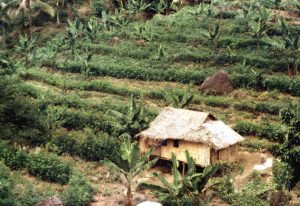“At first, everything was just fine,” Manong Doming recalled. “We had enough and almost everything was affordable. We practice kaingin (slash-and-burn farming). Land was fertile and the use fertilizer was unknown to us then.”
This was in the 1960s when his family moved to the hinterland near Mount Apo, the country’s highest peak. But as the years went by, he noticed something was not right in the method of farming he used.
Manong Doming observed that the produce from the farm considerably declined. This was evident in the corn he was planting. Over a period of 10 years, the corn production had dropped from 3.5 tons per hectare to only half ton.
But it was not only corn that was affected. Yields of other crops like banana, coffee, coconut and even fruit trees had also decreased by more than 50% over the same period. “Whatever happened?” he wondered.
To augment his production, Manong Doming started using fertilizer. He also used seeds of improved varieties of corn and other crops. To eliminate pests and diseases attacking his crops, he sprayed them with pesticides.
Manong Doming is just one of the many upland farmers tilling those areas which are supposed to be precarious and should be teemed with forests. But as population continues to grow, these areas are not spared from development.
In the Philippine context, the uplands are rolling to steep lands, with slopes ranging upward from 18 percent. About 60% of the country’s total land area of 30 million hectares are classified as uplands, according to the Department of Environment and Natural Resources (DENR).
Poorest of the poor, marginalized, illiterate – these are just some of the terms used to describe the upland farmers. But the Mindanao Baptist Rural Life Center (MBRLC), a non-government organization based in Kinuskusan, Bansalan, Davao del Sur, considers them “neglected.”
“The upland farmer faces a very dark future unless something is done for him very soon,” said Harold R. Watson, former MBRLC director and recipient of the 1985 Ramon Magsaysay Award for peace and international understanding. “He is the least educated, least paid, least healthy, least hopeful, and most neglected – in terms of agricultural development – of all people in the Philippines.”
On why they belong to the “poorest of the poor” in the Philippine society, demographers say they survive below the poverty line level. The impoverished situation is reflected in their houses made of bamboo, tree bark and cogon thatch roofing. Their source of drinking water is either mountain springs or streams.
In terms of education, the upland farmer rarely finishes grade school. Studies show that he either drops out after the third grade or does not even attempt to enter school. His wife, like himself, fares no better.
“The inhabitants are primarily farming families in dire poverty and insecurity,” notes a study entitled Agricultural Sustainability and the Environment in the Humid Tropics, which was commissioned by the National Research Council Project (NRCP). “Subsistence food production, rather than forestry, is their overriding priority.”
Most of these uplanders belong to the category of “small farmers,” according to the Rome-based Food and Agriculture Organization (FAO). “Even with reasonable amounts of fertile land,” said the United Nations specialized agency, “most face serious obstacles – the lack of appropriate technology and agricultural inputs, inadequate marketing facilities and poor community services such as sanitation, medical care and education. The result is widespread poverty and malnutrition, and all their attendant miseries.”
In the past, these small farmers owned modest lots to till but when globalization and commercialization took place, they were uprooted. In Mindanao, for instance, when commercial agricultural plantations of banana and pineapple expanded, the poor Uplanders were pushed onto marginal lands.
“As effective control of agricultural land becomes more concentrated in the hands of wealthier farmers and corporations, small farms are becoming smaller,” said the NRCP-commissioned study.
This resulted to making uplands as the “last frontier” for these poorer farmers. Charles Castro echoed this concern in his 1984 paper, “Uplands and Uplanders: In Search for New Perspective”:
“Even if the Philippine government poured all of its resources, money, and talent in expanding the carrying capacity of lowlands, it would still become all too clear that the next focus for rural development efforts will have to be the uplands. For it is in the uplands where supplementary and additional food sources will be grown. It is in the uplands which will give Filipinos temporary elbow room for the land shortage.”
Castro further wrote: “It is in the upland here landless rural people will find a new option in lighting rural poverty. It is in the uplands where alternative for fossil fuel requirements may be produced. It is in the uplands where consequently new problems of tenure, social justice, and human rights will be fought, and it is in the uplands where long-term viability of resources needed by the densely-populated areas such as irrigation water, timber, and coastal and fishery resources can be established.”
Unfortunately, these uplands are not well suited to high population densities because of steep slopes, fragile soils, and torrential rainfall. “Deforestation and inappropriate land use practices that result from high population densities and scarce land resources have serious consequences,” Victor O. Ramos, then an environment official, reminded in a 1991 paper.
According to Ramos, denuded forest land experience 100 tons of soil loss per hectare in contrast to less than 8 tons per hectare per year from natural forests. Slash-and-burn farming, which most uplanders practice, has an erosion rate of 300-400 tons per hectare per year.
“Soil erosion is an enemy to any nation — far worse than any external enemy coming into a country and conquering it because erosion is an enemy you cannot see vividly,” said Watson. “It’s a slow creeping enemy that soon possesses the land.”
Watson warned that soil erosion will imperil the country’s food supply in the coming years. “Soil is made by God and put here for man to use, not for one generation but forever,” he reminded. “It takes thousands of years to build one inch of topsoil but only one good strong rain to remove one inch from unprotected soil on the slopes of mountains.”
The MBRLC came into existence just a year before Martial Law was declared. Farmers came to the center and oftentimes complained of low and declining farm yields. They also expressed the need for better income distribution throughout the year. There were times during the year when a family had no money or food since they depended on a seasonal monocropping system.
Recognizing these problems, the MBRLC tried to find ways. Watson and his staff kept experimenting, searching for something simple and practical that could help stem the tide of topsoil washing down the mountainsides. They believed soil erosion was the primary culprit of low production.
One day, they gathered together to brainstorm. “We decided to start with what we knew,” Watson recalled. “We could run a contour or a terrace line, but how could we keep it there? Suppose we took this ‘miracle plant’ people had been talking about growing in the flatlands and put it around the terrace in hedgerows.”
The “miracle plant” he was referring to was “ipil-ipil,” known in the science world as Leucaena leucocephala. (When it was devastated by psyllid infestation in later years, the MBRLC recommends other nitrogen-fixing species like Desmodium rensonii, Flemingia macrophylla and Gliricidia sepium.)
“It’s a legume, we would be enriching the soil,” Watson further said. “Then, we’d take the green leaves of this plant and put them back on the soil. We knew that one line wouldn’t hold the soil, so we said, ‘Let’s make a double line.’”
They got excited. If the method worked, it would stop erosion, rebuild soil and increase crop yield. Within an afternoon, the basic theory of Sloping Agricultural Land Technology (SALT) was born.
 “SALT is one of the solutions to the problems that beset the world these days,” said Roy C. Alimoane, the current MBRLC director. “But it seems that most experts are looking for big things that can help curb, if not arrest, the difficulties this planet has gotten into.”
“SALT is one of the solutions to the problems that beset the world these days,” said Roy C. Alimoane, the current MBRLC director. “But it seems that most experts are looking for big things that can help curb, if not arrest, the difficulties this planet has gotten into.”
Just like the prophet David defeated giant Goliath with just a sling shot and a stone, the problems can be solved by going back to the basics, Alimoane said. “We don’t need modern technologies and high gadgets to defeat the enemy. All we have to do is use what God has provided us through the years.”
SALT is one possible answer that should be given much attention. “Basically, the SALT method involves planting of field and permanent crops in 4-5 meter bands between double-controlled rows of nitrogen fixing trees and shrubs,” explains Alimoane.
Examples of field crops are the legumes (beans, peas, and pulses), cereals (upland rice, corn, and sorghum), root crops (sweet potato, cassava, carrot, and taro), and vegetables (cabbage, ampalaya, tomato, eggplant, etc.). Permanent crops include cacao, coffee, banana, citrus, and fruit trees.
This is where food security comes in. “Most farmers are locked into one crop,” Alimoane points out. “When the crop is harvested, he has much money, but it is soon gone, and he has overspent. He’s called a millionaire for one day.”
With SALT, a farmer can harvest every now and then. “He has something to look for,” Alimoane says. “Because the harvested crops are just enough for the market, there is a tendency that the price of his produce is much higher.”
Organic farming is practiced in the SALT scheme. Double hedgerows of leguminous perennials are planted at 4-5 meter intervals on equal-elevation contours. The hedgerows are pruned frequently (every 5-6 weeks) and the cuttings are applied to the crops as source of fertilizer. The cuttings also served as mulching materials.
In the SALT farm, you find a mix of permanent crops, cereals, and vegetables. Every third strip of available land is normally devoted to permanent crops. A combination of various cereals and vegetables are planted on the remaining two strips of land. Each has its own specific area so that there can be a seasonal rotation.
“Crop rotation helps to preserve the regenerative properties of the soil and avoid the problems of infertility typical of traditional agricultural practices,” explains Alimoane on the importance of regular rotation of crops.
The principle of SALT is the same as that used by the Ifugao tribes 300 years ago. “All we are doing is suggesting using nitrogen fixing trees and shrubs (mentioned earlier) instead of rocks,” Alimoane points out. “We recommend that a combination of these species be planted all over the SALT farm.”
SALT can help control soil erosion. A seven-year study conducted at the MBRLC showed that a farm tilled in the traditional manner erodes at the rate of 1,163.4 metric tons per hectare per year. In comparison, a SALT farm erodes at the rate of only 20.2 metric tons per hectare per year.
The rate of soil loss in a SALT farm is 3.4 metric tons per hectare per year, which is within the tolerable range. Most soil scientists place acceptable soil loss limits for tropical countries like the Philippines within the range of 10-12 metric tons per hectare per year. The non-SALT farm has an annual soil loss rate of 194.3 metric tons per hectare.
As SALT is an example of agroforestry (a collective name for all land-use systems and practices where woody perennials and crops are planted together), it offers other valuable ecological advantages.
“SALT greatly reduces the risk of drought, landslides, floods, the silting over of low-lying areas, and wind erosion — all of which are linked to the radical transformation of the natural environment and the destruction of the mountain forests,” Alimoane says.
But Alimoane admits that it’s not an easy task to follow the SALT system diligently. “We have had our failures, too,” he admits. “I can take you to a lot of farms that started out with SALT, and about halfway through the farmers just gave up. Part of it could be our fault; maybe we didn’t motivate them enough.”
Maybe MBRLC’s approach is still not completely right. After all, there is no perfect technology or solution for a developing country like the Philippines. “The whole thing is terribly complex,” sighed now-retired Watson when he was still in the country. “When you start to fill up a big hole, it takes a lot of shovelfuls. In an economy like this, in a poor country like this, it takes a lot of grains of sand.”







